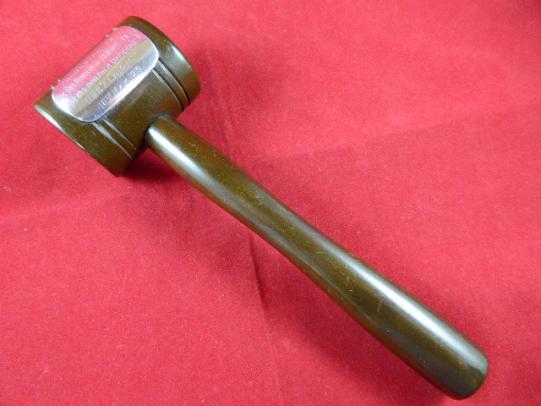Unique WW1 H.M.S. ALBION Lignum Vitae Gavel with Engraved Silver Presentation Plaque to The Rev Norman de Jersey RNVR – 18th May 1916
Here on offer is a unique WW1 period, H.M.S. Albion lignum vitae gavel with engraved silver presentation plaque to “The Rev Norman de Jersey” RNVR – 18th May 1916.
The gavel itself has been beautifully made from two pieces of solid lignum vitae wood.
Affixed on the front is a small solid silver plaque that has been professionally engraved with the following:
PRESENTED TO
The Rev Norman de Jersey RNVR
BY HIS BROTHER OFFICERS
H.M.S. “ALBION”
18th MAY 1916
There are no marks on the silver plaque, but it does test positive for 925-grade silver.
Some facts about Norman Stewart de Jersey:
He was born on Guernsey on 3 January 1866, the third son of Carey Brock De Jersey.
After his university years at Pembroke College and Ridley Hall, Cambridge, he was ordained in 1891.
He served as curate in Bristol (1891-93) and Kilburn (1893-6), and then became a Missions to Seamen chaplain for Bristol, Avonmouth and the Channel between 1898 and 1919.
During the First World War, he volunteered as acting chaplain for temporary service with the Royal Navy, and served on H.M.S.ALBION, 1914-16, and in the Cruiser Fleet, 1916-18.
He was decorated in 1922. On returning to his work with the Missions to Seamen, he was appointed Honorary Canon of Bristol. He was one of the founders of the Bristol City and Maritime Ambulance Corps in 1900.
De Jersey was consecrated fourth Bishop of the Falkland Islands in St Paul's Cathedral, London on 24 June 1919, with the same jurisdiction as his predecessor, Bishop Blair.
During his episcopate, De Jersey increased the numbers of English-speaking clergy serving in the diocese to 18.
He organised a series of diocesan synods between 1921 and 1932. His association with the Falkland Islands was recognised by his appointment from 1928 to 1934 as chaplain 1st class of the Falkland Islands Defence Force with the rank of colonel.
In contrast to Bishop Blair, De Jersey was an outdoors man. His recreation was yachting. His episcopate was a time of consolidation and growth among the Anglican congregations. He died, unmarried, at the age of 68, on 28 November 1934, having only just retired.
HMS ALBION was a pre-dreadnought battleship of the British Royal Navy and a member of the Canopus class. Intended for service in Asia, ALBION and her sister ships were smaller and faster than the preceding Majestic-class battleships, but retained the same battery of four 12-inch (305 mm) guns. ALBION was laid down in December 1896, launched in June 1898, and commissioned into the fleet in June 1901.
ALBION spent the first few years of her career abroad on the China Station from 1901 to 1905, before returning to British waters to serve with the Channel Fleet and later the Atlantic Fleet. After the outbreak of WW1 in August 1914, she was mobilised and returned to the Channel Fleet, but was quickly sent to the Atlantic to help defend against the possibility of German warships breaking out of the North Sea. In December and January 1915, she supported operations against German Southwest Africa.
The ship was transferred to the Mediterranean Sea in January 1915 to participate in the Dardanelles Campaign. She participated in major attacks on the Ottoman coastal fortifications defending the Dardanelles in March 1915, but the British and French fleets proved incapable of forcing the straits. During these operations, ALBION was damaged by Ottoman artillery twice. In October 1915, she was transferred to Salonika to support the Allied operations against Bulgaria through then-neutral Greece, but she saw no further action. She was transferred back to Ireland in April 1916 for service as a guard ship, a role she filled until October 1918, when she was reduced to a barracks ship. ALBION was sold for scrap in December 1919 and broken up the following year.
This is a really fascinating piece of WW1 Royal Navy memorabilia with the connection to a prominent member of the clergy.
The gavel measures 7.5” (19cm) long and the gavel head is 1.6” (4cm) diameter.
It weighs 137.5g.
Please see my pictures for the details of the condition, which complement this description.
Please see my TERMS OF BUSINESS regarding Deliver Charges and Insurance regarding additional insurance cover, should you require it, BEFORE the item is dispatched.
The responsibility lies with the customer to check with your Customs restrictions that this item can be imported into your country.
Thanks for taking the time to look.
Code: 50415
100.00 GBP









